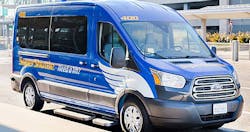With the legal definition of independent contractors under assault in the states and in federal courts, a welcome development is a recent decision made by the National Labor Relations Board (NLRB) that returns to a traditional common law test that had been junked five years ago by the Obama-era board.
The case involved SuperShuttle van drivers who work at the Dallas-Fort Worth International Airport (DFW). The NLRB, by returning to its prior test for applying the board. has provided additional certainty to employers, particularly where workers’ assignments afford them significant room to recognize profits or losses, says William J. Kishman, an attorney with the law firm of Squire Patton Boggs.
Before the Obama board changes, the NLRB had applied the traditional “common-law agency test” to determine whether a worker is an employee or independent contractor under the National Labor Relations Act (NLRA).
This common law test considers several factors, including:
● How much control the contracting company exercises over the worker.
● Whether the worker’s services fall outside core competencies.
● Whether the contracting company provides the tools, equipment and place of work.
● How long the worker has served that company.
● How the worker is paid.
● Whether the worker has significant “entrepreneurial opportunity,” i.e., whether the situation afforded the worker significant room to generate profits or, alternatively, to recognize losses.
This last standard seems to have offered the current board majority what it believes to be the strongest argument for overturning the Obama-board’s changes, thus affording significant weight to the entrepreneurial test. At the same time, the traditional standard is expected to decrease emphasis on whether the worker has the “right to control” key aspects of the services, although the board will still consider this as part of a larger analysis.
The SuperShuttle case involved individuals who had acquired “franchises” to operate airport shuttle vans by contracting with a franchisor that had acquired the necessary licenses and created the business model. Ultimately, the board found that the franchisees were independent contractors, rather than employees, after noting that the franchisees:
● Had almost total control over their schedules.
● Could choose how much, or how little, they worked.
● Kept all of the fares they collected, and were responsible for most of their own expenses.
● Were not in direct communication with the franchisor on a day-to-day basis.
● Were paid by customers, rather than the franchisor.
● Owned their vans, paid directly for their fuel and maintenance, and were directly responsible for most of their other costs.
The NLRB decision explicitly stresses that it will not apply the entrepreneurship question in a rigid and mechanical manner and serve as an end-all-be-all factor in the analysis. As the board states, it should not be treated as a “superfactor,” an “overriding consideration,” a “shorthand formula” or a “trump card” in the independent contractor analysis.
Although the board stresses that it intends to continue assessing independent contractor questions on a case-by-case basis, SuperShuttle DFW provides a good illustration of the facts that it considers most important, Kishman points out. “Now that the board has increased its emphasis on the entrepreneurial control factor, employers have a clearer route for improving their position under the independent contractor analysis for the purposes of the NLRA.”
About the Author

David Sparkman
founding editor
David Sparkman is founding editor of ACWI Advance (www.acwi.org), the newsletter of the American Chain of Warehouses Inc. He also heads David Sparkman Consulting, a Washington D.C. area public relations and communications firm. Prior to these he was director of industry relations for the International Warehouse Logistics Association. Sparkman has also been a freelance writer, specializing in logistics and freight transportation. He has served as vice president of communications for the American Moving and Storage Association, director of communications for the National Private Truck Council, and for two decades with American Trucking Associations on its weekly newspaper, Transport Topics.
